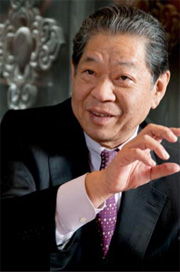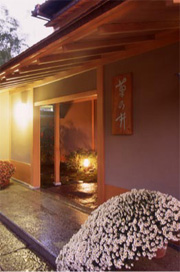Home > Highlighting JAPAN > Highlighting Japan APRIL 2012 > The Gentle Power of Umami
Highlighting JAPAN
COVER STORY: Food, Glorious Japanese Food
The Gentle Power of Umami
Founded in 1912, Kikunoi in Kyoto—or specifically the main branch of the restaurant—has since 2010 been recognized with three stars in the Michelin Guide to exceptional restaurants. Yoshihiro Murata, chef and third generation owner of Kikunoi as well as director of the NPO Japanese Culinary Academy, speaks with the Japan Journal's Osamu Sawaji about the appeal of Japanese cuisine.

Yoshihiro Murata, chef and owner of Kikunoi
Credit: MASATOSHI SAKAMOTO
What do you think is the essence of Japanese cuisine?
Yoshihiro Murata: It is a cuisine that places umami at its heart. Umami can be found in ingredients such as kombu (kelp), katsuo (bonito) and shiitake mushrooms. Umami is the fifth taste along with sweetness, sourness, saltiness and bitterness, and as such is a Japanese word that has gained currency across the world. The dashi stock used in Japanese cuisine is made by simmering kelp, bonito and shiitake mushrooms in water to extract the substances which contain umami. By combining kelp with bonito, the umami is said to be eight times stronger than the umami gained from just using kelp. By combining kelp with shiitake, the umami is sixteen times stronger. The delicious flavor of Japanese cuisine comes from this use of dashi.
Why do you think Japanese cuisine is being accepted across the world?
A major reason is that Japanese cuisine is healthy. A kaiseki cuisine meal uses sixty-five ingredients and has about 1,000 kilocalories, whereas similar French meals use twenty-five ingredients and contain 2,500 kilocalories. Japanese cuisine replaces the fats, oils and sugar used in large quantities in Western cuisine with umami, reducing the calorie count. It is also very satisfying. Another reason for the spread of Japanese cuisine is the quality of ingredients. I have tasted the ingredients of cuisines from countries around the world and I feel that the flavor and quality of Japanese agricultural and marine products such as fish, vegetables and fruits are among the finest in the world. For example, I've never tasted anything overseas as sweet as a Japanese strawberry.
The quality of Japanese foodstuffs is becoming known globally, and chefs across the world have started to use them. For example, a novel use overseas is that of yuzu, a citrus fruit that has been used as a flavoring in Japan for many years. The unique fragrance and bitterness of yuzu is a reason for its popularity.
Is it possible to cook Japanese food at home outside Japan?
It is possible to cook Japanese food by using local foodstuffs. For example, it's possible to get soy sauce, a well-known Japanese condiment, at supermarkets in most countries in the world. You can make teriyaki sauce by mixing soy sauce with sugar. By cooking meat coated in this sauce, you can create splendid Japanese food. I hope that people will be able to enjoy Japanese cuisine at the family dinner table in many countries.

The entrance to Kikunoi in Kyoto
Credit: COURTESY OF KIKUNOI
Could you tell us about your overseas activities?
I get invited to go over to other countries in Asia, the United States, Europe, and other parts of the world to cook Japanese food. In April this year, I have been invited to the Metropolitan Museum of Art in New York to prepare Japanese food for over a hundred people. The Great East Japan Earthquake doesn't seem to have had any detrimental impact on Japanese food. These days, Japanese is regarded as one of the leading cuisines of the world.
In June this year, my company in London will be opening a Japanese restaurant called Chrysan in conjunction with a London-based investment company. It is located in the City, the financial heart of London and one of the major financial and economic centers anywhere in Europe. We also decided on London because it is currently in the run-up to the Olympics.
I can't really say anything about the menu, but the chefs are from Kikunoi and will be making dishes that are sure to delight people in London. We are going to be using exclusively British ingredients wherever possible.
How do you see Japanese food changing in the future?
As Japanese food is becoming truly global, I expect that we will see greater fusion with dishes from other countries in the future. I think more chefs will start making Japanese food using local ingredients from their own countries. I definitely see adapting Japanese food to suit people's tastes in other countries as a good thing. Take sushi dishes like California rolls or soft shell crab rolls. They were developed outside Japan, but they still taste just as great.
There are plenty of successful Japanese chefs out there who have created Japanese dishes to suit people in other countries. Tetsuya Wakuda for instance, the owner and chef at Tetsuya in Sydney, Australia, is famous for his fusion dishes combining Japanese and French cuisine. Another example is Nobuyuki Matsuhisa, the owner and chef at Nobu in New York. By creating sushi dishes to suit people's tastes in Europe and the United States, he has had a big hand in making Japanese food more popular.
I hope we will see more Japanese chefs like these successfully branching out into other countries in the future. In fact, I hope that my new restaurant in London will lead the way in terms of showcasing the next generation of Japanese chefs to the rest of the world.
© 2009 Cabinet Office, Government of Japan






